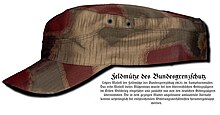Cap
Appearance
A cap is a form of headgear. Caps have crowns that fit very close to the head and have no brim or only a visor. They are typically designed for warmth and, when including a visor, blocking sunlight from the eyes. They come in many shapes and sizes
Types of cap



- Ascot cap
- Ayam
- Balmoral
- Baseball cap
- Beanie
- Beret
- Biretta
- Cap of Maintenance
- Casquette
- Caubeen
- Coif
- Combination cap (also known as a service cap)
- Cricket cap
- Do-rag
- Dutch cap
- Engineer cap
- Fez
- Fiddler cap (also known as a Dutch boy hat)
- Fitted cap
- Flat cap
- Forage cap
- Gandhi cap
- Garrison cap
- Glengarry
- Greek fisherman's cap
- International cap
- John Lennon cap
- Juliet cap
- Kepi
- Kippah (also known as yarmulke)
- Kufi (also known as a kofia; an African cap worn with a dashiki)
- Muir cap
- Newsboy cap
- Nightcap
- Nurse cap
- Patrol cap
- Peaked cap
- Rastacap
- Sailor cap
- Shako
- Sindhi topi
- Square academic cap
- Tam o' Shanter
- Taqiyah, worn by Muslim males
- Toboggan
- Trucker hat
- Tubeteika
- Tuque or stocking cap, wool cap, watch cap, ski cap
- Utility cover
- Welder's cap
- Yachting cap
- Zucchetto
See also
- List of hats and headgear
- Bonnet, until about 1700 the usual word for brimless male headgear.
External links
- My Kingdom for a Crown: An Around-the-World History of the Skullcap and its Modern Socio-Political Significance, by Reverend Antonio Hernandez (pdf) -- a thorough history of the skullcap, with chapters on the yarmulke and the beanie among others.
